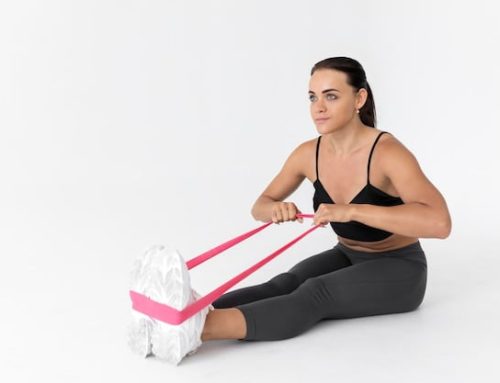Introduction
Resistance band training has grown in popularity over the years, and for good reason. Not only is it one of the most effective ways to build strength and increase endurance, but it also has a host of benefits for your joints. If you’re looking for an exercise routine that is both challenging and easy on your joints, then resistance band training may be just what you need.
What are Resistance Bands?
Resistance bands are elastic bands made from rubber or latex that come in different sizes and strengths. They can be used to perform a variety of exercises that target different muscle groups in your body. The resistance provided by the bands is what makes them such a powerful tool for strength training.
Resistance bands help in rehabilitation
These are popular accessories in the hands of a physiotherapist, which make it possible to improve movement with variable resistance. Exercises with tapes are recommended after surgeries, joint injuries, soft tissue overloads, or after long immobilizations. They are also often used to correct posture defects. Rubber bands are used for rehabilitation, which are very stretchy, with a low level of resistance – prepared for the therapy of weakened muscles. Thanks to exercises with bands, we improve the range of motion and coordination. Regular exercises under the supervision of specialists allow you to improve muscle performance and improve fitness and mobility.
Advantages of training with resistance bands
Training with rubber bands is a great option to diversify strengthening training and introduce resistance training. This can be an introduction to strength exercises, but not only – with the appropriate resistance of the tapes, it can easily (especially in the initial phases) replace strength training. It is definitely a good activity for both people who care about their figure and those who simply want to have a fit and strong body. It will also be useful for runners as a form of supplementary training.
How do Resistance Bands Benefit Your Joints?
One of the biggest benefits of resistance band training is that it is low-impact, which means it puts less stress on your joints. When you lift weights or perform other high-impact exercises, the pressure on your joints can cause pain, discomfort, and even injury. Resistance bands, on the other hand, allow you to work your muscles without putting undue stress on your joints. This makes it a great option for people with arthritis, joint pain, or other conditions that affect their joints.
Resistance bands can benefit your joints in several ways:
- Low-impact exercise: Resistance bands provide a low-impact form of exercise that is gentle on the joints. Unlike traditional weights, resistance bands provide constant tension throughout the movement, reducing the stress on the joints.
- Improved range of motion: Resistance bands can help improve joint flexibility and range of motion. By providing resistance throughout the entire range of motion, resistance bands can help increase joint mobility and reduce stiffness.
- Increased muscle strength: Resistance bands can help strengthen the muscles around the joints, providing better support and stability. This can help reduce the risk of joint injury and improve overall joint health.
- Injury rehabilitation: Resistance bands can be a useful tool for injury rehabilitation, as they allow for targeted resistance exercises that can help strengthen the injured joint or muscle group without causing further damage.
- Versatility: Resistance bands offer a wide range of exercises that can target specific muscle groups and joints. This versatility can help provide a full-body workout that can improve overall joint health and reduce the risk of joint pain or injury.
In summary, resistance bands can benefit your joints by providing a low-impact exercise that improves joint flexibility and range of motion, increases muscle strength, and helps with injury rehabilitation. Their versatility also allows for a wide range of exercises that can target specific muscle groups and joints.
Studies on Resistance Bands and Joint Pain
Studies have shown that resistance band training can be beneficial for people with knee osteoarthritis. One study found that people who performed resistance band exercises for 12 weeks experienced significant reductions in knee pain and improvements in physical function. Another study found that resistance band training was just as effective as traditional strength training for reducing pain and improving function in people with knee osteoarthritis.
Other Benefits of Resistance Band Training
Resistance band training has a number of other benefits as well. For one thing, it is incredibly versatile. Resistance bands can be used to perform a wide range of exercises, from bicep curls to squats to shoulder presses. This makes it a great option for anyone looking to switch up their exercise routine and challenge themselves in new ways.
Resistance band training is also great for building strength and increasing endurance. Because the resistance provided by the bands is constant throughout the range of motion, it requires your muscles to work harder than they would when lifting weights. This leads to greater gains in strength and endurance over time.
How to Get Started with Resistance Band Training
If you’re interested in trying resistance band training for yourself, there are a few things you’ll need to know. First, you’ll need to invest in a set of resistance bands that are appropriate for your fitness level. Bands come in different resistance levels, so be sure to choose ones that are challenging but not impossible for you to use.
Once you have your bands, there are countless exercises you can do with them. Some of the most popular exercises include bicep curls, tricep extensions, push-ups, lunges, and squats. You can find instructional videos online that demonstrate how to perform these exercises correctly and safely.
Best Exercises You Can Do With A Resistance Band
Resistance bands are a versatile piece of exercise equipment that can be used to strengthen and tone different muscle groups. Here are some of the best exercises you can do with a resistance band:
| Exercise Name | Muscle Group Targeted |
|---|---|
| Bicep curls | Biceps |
| Tricep extensions | Triceps |
| Shoulder press | Shoulders |
| Lat pulldowns | Back, shoulders |
| Glute bridges | Glutes |
| Squats | Legs, Glutes |
| Leg curls | Hamstrings |
| Lateral leg lifts | Outer thighs |
| Chest flyes | Chest |
| Seated rows | Back, shoulders |
Conclusion
In conclusion, resistance band training is a great option for anyone looking to improve their strength, endurance, and overall fitness without putting unnecessary stress on their joints. It is versatile, effective, and easy to do at home or on the go. If you’re interested in trying resistance band training for yourself, be sure to invest in a set of high-quality bands and start with exercises that are appropriate for your fitness level. With time and practice, you can build strength, improve function, and reduce joint pain with this simple but powerful exercise tool.






